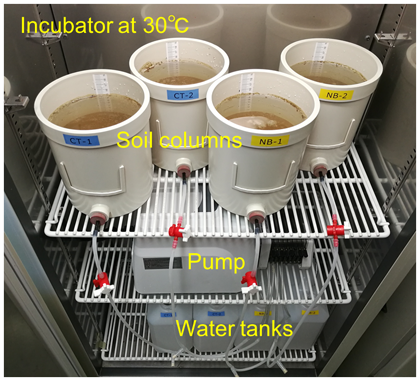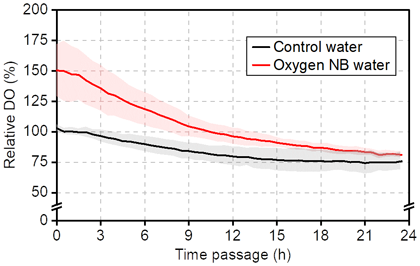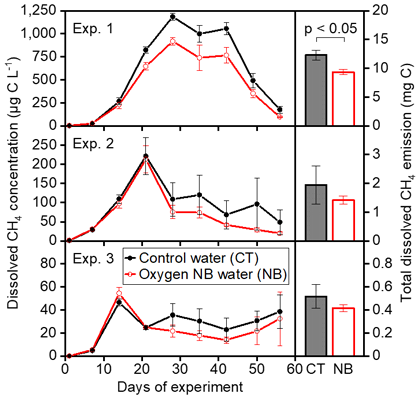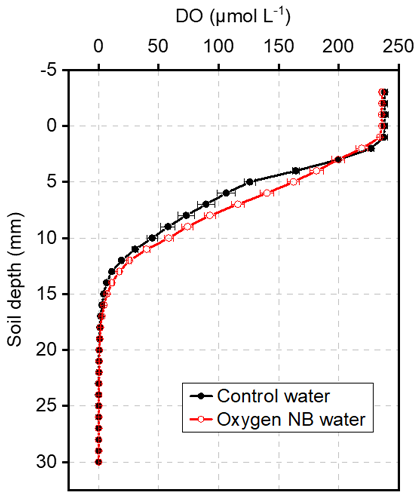Oxygenation of flooded paddy soil and inhibition of methane production through irrigation with water containing bulk oxygen nanobubbles
Description
Rice cultivation is one of the major anthropogenic sources of methane (CH4), a potent greenhouse gas. Methane is produced in flooded paddy soils under reductive conditions, thus surface water drainage, such as midseason drainage and alternate wetting and drying (AWD), is effective in reducing CH4 emission through soil oxidation. However, the feasibility of drainage practices is limited spatiotemporally in wet seasons and lowlands with poor drainage. To reduce CH4 emission from flooded paddy soils, we proposed an irrigation scheme using water containing bulk nanobubbles (NBs) (Minamikawa et al. 2015). NBs are tiny bubbles (<1 µm diameter) made of various gases that have unique properties including a long lifetime in water. We had demonstrated that oxygen NB water (i.e., water with NBs made of pure oxygen) significantly reduced the direct CH4 emission by 21% in a pot experiment, but the mechanisms underlying the emission reduction had remained unclear. This study hypothesized that the emission reduction is caused by the oxygenation of flooded soil through the leaching of oxygen NB water. To test it, we carried out three soil-column experiments using a Fluvisol under flooded and rice-unplanted conditions (Fig. 1).
Oxygen NB water prepared by the swirling flow method using a commercial NB generator had a mean particle size of 185 ± 57 nm (standard deviation) and a particle density of 7.0 × 107 mL−1. We used aerated tap water as control water, and the initial dissolved oxygen (DO) concentration in surface water was comparable to that equilibrated with ambient air at a given temperature (Fig. 2). On the other hand, the initial DO in oxygen NB water a few hours after the preparation was still 1.5 times that in control water and the DO remained higher within 24 hours. Under different soil conditions in labile carbon content (i.e., high in experiment 1, middle in 2, and low in 3), the total CH4 emission dissolved into leaching water for 56 days was 20%–28% lower in oxygen NB water than in control water (Fig. 3). Measuring DO profile at 1-mm intervals at the soil–water interface using an oxygen microelectrode and a micromanipulator, we found that oxygen depletion at shallow depths (4–15 mm from the soil surface) was ameliorated by oxygen NB water on day 35 of experiment 2 (Fig. 4). The result confirms that irrigation with oxygen NB water reduces CH4 production in a flooded paddy soil through oxygenation of shallow soil.
The results provide researchers with the scientific basis for the use of oxygen NB water as a measure to control redox conditions in various aquatic environments, including flooded paddy soils. There is still room for improvement in soil oxygenation by raising the irrigation frequency. Further study is necessary to elucidate whether the oxygen is in dissolved form and/or as intact particles when delivered to a flooded soil through oxygen NB water.
Figure, table
-
Fig. 1. Apparatus consisting of soil column systems for the three experiments
Water is leached at a fixed rate (1.73 cm day-1) by the pump. -
Fig. 2. Temporal shifts in surface water DO in Experiment 2
Values relative to that equilibrated with ambient air at a given temperature.
Solid lines indicate the means of four measurements, and bands indicate the standard deviations. -
Fig. 3. Temporal shifts in dissolved CH4 concentrations (left panels) and the total emissions (right panels) in the three experiments
Vertical bars indicate the standard errors (n = 3). -
Fig. 4. DO profiles at the soil–water interface on day 35 of Experiment 2
Horizontal bars indicate the standard errors (n = 3).
- Affiliation
-
Japan International Research Center for Agricultural Sciences Crop, Livestock and Environment Division
- Classification
-
Technical A
- Research project
- Program name
- Term of research
-
FY2019 (FY2016-FY2018)
- Responsible researcher
-
Minamikawa Kazunori ( Crop, Livestock and Environment Division )
Makino Tomoyuki ( Tohoku University )
- ほか
- Publication, etc.
-
https://doi.org/10.1016/j.scitotenv.2019.136323
Minamikawa K and Makino T (2020) Science of the Total Environment, 709:136323
- Japanese PDF
-
2019_A02_A4_ja.pdf929.49 KB
2019_A02_A3_ja.pdf256.25 KB
- English PDF
-
2019_A02_A4_en.pdf1.36 MB
2019_A02_A3_en.pdf226.57 KB
- Poster PDF
-
2019_A02_poster_fin.pdf263.44 KB




